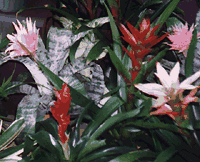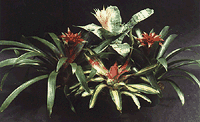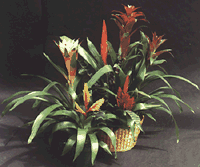General Rule
Even with bromeliads' exotic native locales, they are one of the most amenable plants to the artificial conditions found in the average home. Success depends upon how closely the grower can match the conditions found in its native habitat. By carefully studying the appearance of a bromeliad, one can tell with some degree of certainty the care and conditions it needs. As a general rule, the stiffer and more stout the foliage, the more light is needed to bring out the true characteristics of the plant. The more colorful the foliage and the more prominent the leaf pattern, the less light is usually required.

Air
Since bromeliads are also known generally as 'air plants' most will never attain their full magnificence if they do not have plenty of fresh, moving air. Bromeliads collected from treetops amongst the elements will not be happy in a situation with stagnant air nor direct drafts.
Light
Essential to the bromeliad's appearance is the amount of light. Always remember that the sun shines quite differently in different places around the world. The sunlight along the coast lacks the intensity of the sunlight in inland valleys. In addition, light coming through a windowpane is much different than a greenhouse wall. Careful attention should be taken to notice that the light does not burn the leaves of distort their shapes but still brings out the best coloration and form. Bright and indirect natural light is best, although experimentation is always needed in a new environment.
Water
A plant with soft, green leaves that form a rosette which can hold water in it's cup usually needs shaded, humid conditions and moisture in the reservoir at all times. Other bromeliads with stiff, succulent leaves and few places to hold moisture can withstand more light and even periods of drying.
Temperature
Even with their wide distribution there are only a handful of bromeliads that can withstand prolonged freezing temperatures. By knowing the original habitat of the plant, it is fairly easy to determine what temperatures it will handle. Generally, the higher the elevation of its native habitat the more cold it will handle. Most bromeliads seem to thrive when night temperatures are about 60 degrees F making the average household environment very suitable. Again, looking at the foliage helps to make a general determination. The stiffer and more succulent the leaves the more cold it will tolerate.

Soil
Most bromeliads are originally epiphytes but make the transition into terrestrial cultivation readily. Optimal soil is light, porous and acid (low pH). The medium needs to be firm enough to physically hold the plant while but open enough to allow complete drainage after watering. Sterile composts made from fir bark and redwood bark have been used. Aechmeas, guzmanias and vrieseas thrive in a rich compost or mix of mostly peat moss and drainage materials. Many nurseries have orchid or acid-loving plant mixes that are suitable.
Feeding
Being epiphytes, bromeliads utilize the sparse, decomposing organic matter that they are lucky enough to call their home. It is essential that bromeliads are not fertilized too heavily. Most complete fertilizers should be used at no more than half strength and can be both foliar sprayed or added to the soil medium in frequent intervals. Many growers feed their bromeliads with a slow-release, fertilizer pellets. Since many bromeliads are naturally growing under stressful conditions, a bit of fertilizer will help to bring out much of the plant's beauty.

Division & Blooming
A fair amount of patience needs to be exercised when it comes to blooming. The original bloom (lasting from 4-9 months) will fade and die. Bromeliads will produce offshoots (called pups) from the base of the original plant. Eventually, the 'mother' plant will start to decline. Once the pups are of reasonable size (about six inches from the base), they may be separated from their parent by gently pulling them apart or with the aid of a sharp knife. Retaining roots is not absolutely necessary since they are epiphytes. The pup's first pot should be small since roots seem to form more quickly in a crowded container. The pups, given optimum conditions, will flower within two years after they have been severed. Always remember bromeliads are first and foremost a foliage and form plant that produces lasting and spectacular blooms.
Troubleshooting
Sometimes bromeliads will not do well in their particular situation. It is often difficult to reproduce the exact conditions experienced in its native habitat. Sometimes simply moving the plant to a new location, applying slightly heavier feedings or adjusting watering will help encourage flowering and plant vigor. If a plant looks sickly (and few do unless overly abused) it should be given fresh compost, a new location with fresh air and a different watering and feeding program. No two growers will ever be able to reproduce success with the same techniques. It makes the fun of owning and caring for bromeliads an individual effort.










 EMAIL US: longbloom@etropolis.com -- © 1999 longbloom.com -- website design by studio G -- Updated - 2/14/99
EMAIL US: longbloom@etropolis.com -- © 1999 longbloom.com -- website design by studio G -- Updated - 2/14/99










 EMAIL US: longbloom@etropolis.com -- © 1999 longbloom.com -- website design by studio G -- Updated - 2/14/99
EMAIL US: longbloom@etropolis.com -- © 1999 longbloom.com -- website design by studio G -- Updated - 2/14/99